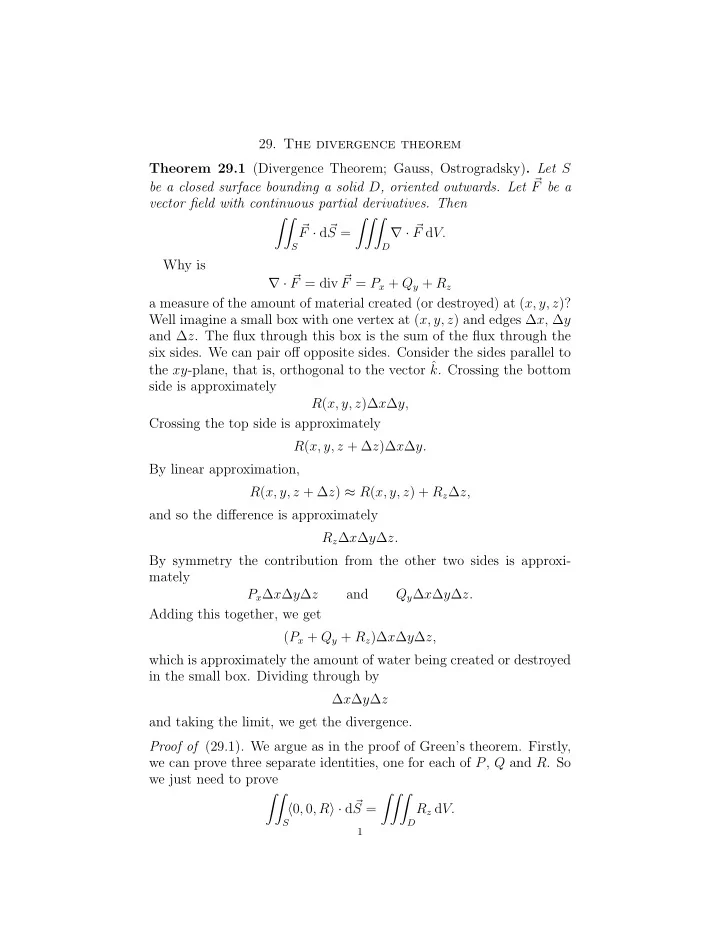

29. The divergence theorem Theorem 29.1 (Divergence Theorem; Gauss, Ostrogradsky) . Let S be a closed surface bounding a solid D , oriented outwards. Let � F be a vector field with continuous partial derivatives. Then �� ��� F · d � � ∇ · � S = F d V. S D Why is ∇ · � F = div � F = P x + Q y + R z a measure of the amount of material created (or destroyed) at ( x, y, z )? Well imagine a small box with one vertex at ( x, y, z ) and edges ∆ x , ∆ y and ∆ z . The flux through this box is the sum of the flux through the six sides. We can pair off opposite sides. Consider the sides parallel to the xy -plane, that is, orthogonal to the vector ˆ k . Crossing the bottom side is approximately R ( x, y, z )∆ x ∆ y, Crossing the top side is approximately R ( x, y, z + ∆ z )∆ x ∆ y. By linear approximation, R ( x, y, z + ∆ z ) ≈ R ( x, y, z ) + R z ∆ z, and so the difference is approximately R z ∆ x ∆ y ∆ z. By symmetry the contribution from the other two sides is approxi- mately P x ∆ x ∆ y ∆ z and Q y ∆ x ∆ y ∆ z. Adding this together, we get ( P x + Q y + R z )∆ x ∆ y ∆ z, which is approximately the amount of water being created or destroyed in the small box. Dividing through by ∆ x ∆ y ∆ z and taking the limit, we get the divergence. Proof of (29.1) . We argue as in the proof of Green’s theorem. Firstly, we can prove three separate identities, one for each of P , Q and R . So we just need to prove �� ��� � 0 , 0 , R � · d � S = R z d V. S D 1
Now divide the region into small pieces, each of which is vertically simple, so that a ≤ x ≤ b c ≤ y ≤ d and f ( x, y ) ≤ z ≤ g ( x, y ) , is the region lying over a rectangle in the xy -plane lying between the graph of two functions f and g . It is enough, because of cancelling, to prove the result for such a region. We calculate both sides explicitly in this case. S has six sides; the four vertical sides and the top and bottom sides. The flux across the four vertical sides is zero, since � F is moving up and down. The flux across the top side is �� �� � 0 , 0 , R � · d � S = � 0 , 0 , R � · �− g x , − g y , 1 � d x d y S top S top � d � b = R ( x, y, g ( x, y )) d x d y. c a The flux across the bottom side is similar, but it comes with the oppo- site sign, so the total flux is � d � b R ( x, y, g ( x, y )) − R ( x, y, f ( x, y )) d x d y. c a For the RHS, we have a triple integral, � d � b � g ( x,y ) ��� R z d V = R z ( x, y, z ) d z d x d y. D c a f ( x,y ) The inner integral is � g ( x,y ) � g ( x,y ) � R z ( x, y, z ) d z = R ( x, y, z ) = R ( x, y, g ( x, y )) − R ( x, y, f ( x, y )) , f ( x,y ) f ( x,y ) so that both sides are indeed the same. � What can we say about a radially symmetric vector field � F , such that there is a single unit source at the origin and otherwise the divergence is zero? By radial symmetry, we have F = � x, y, z � � , c for some c , to be determined. Consider the flux across a sphere S of radius a . The flux across S is �� F · d � � S. S 2
If we orient S so that the unit normal points outwards, we have n = 1 n = a � ˆ a � x, y, z � and F · ˆ c. So the flux is 4 πa 3 . c Since the only source of water is at the origin and we are pumping in water at a rate of one unit there, we must have 4 πa 3 c = 4 πa 3 . = 1 so that c That is F = 1 � x, y, z � � . ρ 3 4 π Typical examples of such force fields are gravity and electric charge. 3
Recommend
More recommend